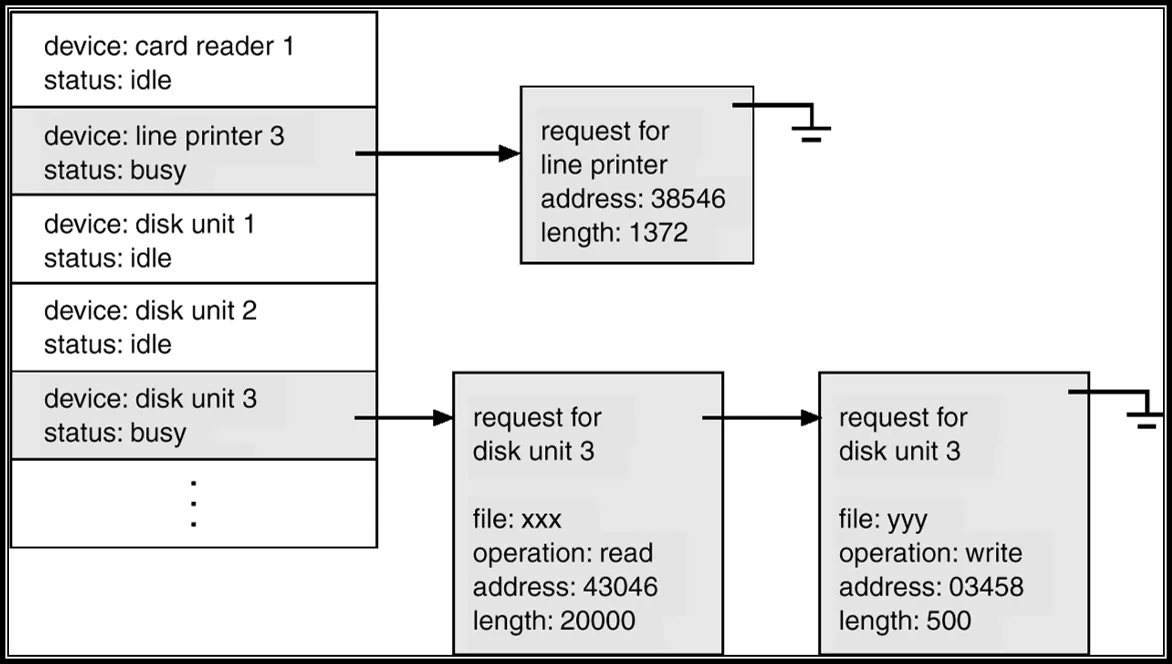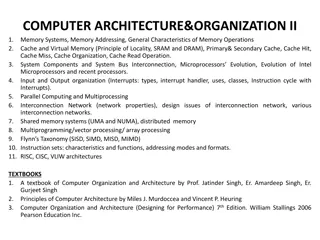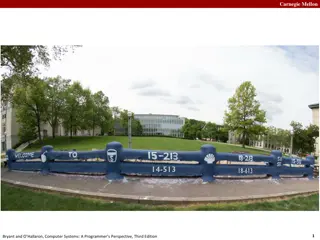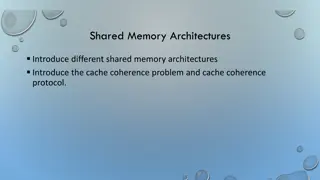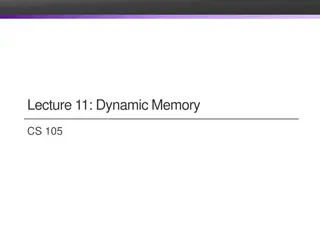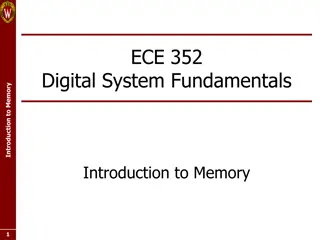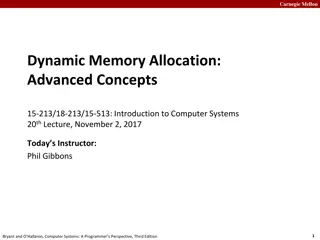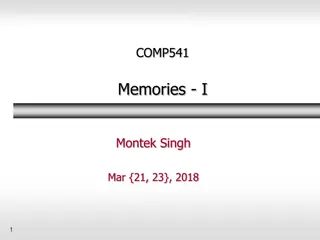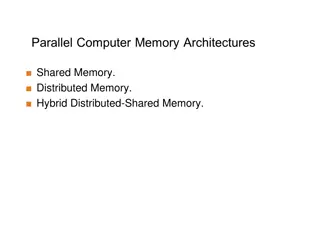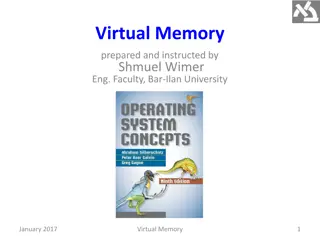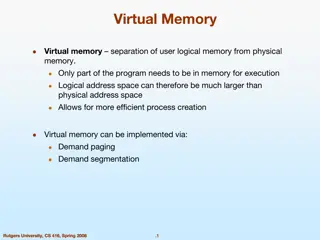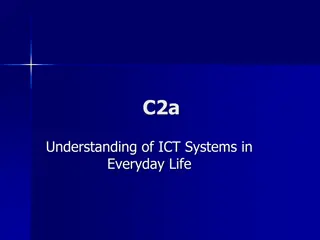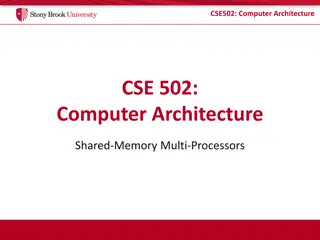Memory Management in Computer Systems
Memory management in computer systems involves optimizing CPU utilization, managing data in memory before and after processing, allocating memory space efficiently, and keeping track of memory usage. It determines what is in memory, moves data in and out as needed, and involves caching at various levels for faster access. Different storage structures like main memory and secondary storage play essential roles, and managing memory is crucial for system performance and user response times.
Download Presentation

Please find below an Image/Link to download the presentation.
The content on the website is provided AS IS for your information and personal use only. It may not be sold, licensed, or shared on other websites without obtaining consent from the author.If you encounter any issues during the download, it is possible that the publisher has removed the file from their server.
You are allowed to download the files provided on this website for personal or commercial use, subject to the condition that they are used lawfully. All files are the property of their respective owners.
The content on the website is provided AS IS for your information and personal use only. It may not be sold, licensed, or shared on other websites without obtaining consent from the author.
E N D
Presentation Transcript
Memory Management All data in memory before and after processing All instructions in memory in order to execute Memory management determines what is in memory when Optimizing CPU utilization and computer response to users Memory management activities Keeping track of which parts of memory are currently being used and by whom Deciding which processes (or parts thereof) and data to move into and out of memory Allocating and deallocating memory space as needed
Storage Structure Main memory only large storage media that the CPU can access directly. Secondary storage extension of main memory that provides large nonvolatile storage capacity. Magnetic disks rigid metal or glass platters covered with magnetic recording material Disk surface is logically divided into tracks, which are subdivided into sectors. The disk controller determines the logical interaction between the device and the computer.
Caching Important principle, performed at many levels in a computer (in hardware, operating system, software) Information in use copied from slower to faster storage temporarily Faster storage (cache) checked first to determine if information is there If it is, information used directly from the cache (fast) If not, data copied to cache and used there Cache smaller than storage being cached Cache management important design problem Cache size and replacement policy
Performance of Various Levels of Storage Movement between levels of storage hierarchy can be explicit or implicit
Migration of Integer A from Disk to Register Multitasking environments must be careful to use most recent value, no matter where it is stored in the storage hierarchy Multiprocessor environment must provide cache coherency in hardware such that all CPUs have the most recent value in their cache Distributed environment situation even more complex Several copies of a datum can exist Various solutions covered in Chapter 17
Storage Management OS provides uniform, logical view of information storage Abstracts physical properties to logical storage unit - file Each medium is controlled by device (i.e., disk drive, tape drive) Varying properties include access speed, capacity, data-transfer rate, access method (sequential or random) File-System management Files usually organized into directories Access control on most systems to determine who can access what OS activities include Creating and deleting files and directories Primitives to manipulate files and dirs Mapping files onto secondary storage Backup files onto stable (non-volatile) storage media
Memory Management Linux s physical memory-management system deals with allocating and freeing pages, groups of pages, and small blocks of memory It has additional mechanisms for handling virtual memory, memory mapped into the address space of running processes Splits memory into 3 different zones due to hardware characteristics
Managing Physical Memory The page allocator allocates and frees all physical pages; it can allocate ranges of physically-contiguous pages on request The allocator uses a buddy-heap algorithm to keep track of available physical pages Each allocatable memory region is paired with an adjacent partner Whenever two allocated partner regions are both freed up they are combined to form a larger region If a small memory request cannot be satisfied by allocating an existing small free region, then a larger free region will be subdivided into two partners to satisfy the request Memory allocations in the Linux kernel occur either statically (drivers reserve a contiguous area of memory during system boot time) or dynamically (via the page allocator) Also uses slab allocator for kernel memory
Virtual Memory The VM system maintains the address space visible to each process: It creates pages of virtual memory on demand, and manages the loading of those pages from disk or their swapping back out to disk as required The VM manager maintains two separate views of a process s address space: A logical view describing instructions concerning the layout of the address space The address space consists of a set of nonoverlapping regions, each representing a continuous, page-aligned subset of the address space A physical view of each address space which is stored in the hardware page tables for the process
Virtual Memory (Cont.) Virtual memory regions are characterized by: The backing store, which describes from where the pages for a region come; regions are usually backed by a file or by nothing (demand-zero memory) The region s reaction to writes (page sharing or copy-on-write) The kernel creates a new virtual address space 1. When a process runs a new program with the exec system call 2. Upon creation of a new process by the fork system call
Virtual Memory (Cont.) On executing a new program, the process is given a new, completely empty virtual-address space; the program-loading routines populate the address space with virtual-memory regions Creating a new process with fork involves creating a complete copy of the existing process s virtual address space The kernel copies the parent process s VMA descriptors, then creates a new set of page tables for the child The parent s page tables are copied directly into the child s, with the reference count of each page covered being incremented After the fork, the parent and child share the same physical pages of memory in their address spaces
Virtual Memory (Cont.) The VM paging system relocates pages of memory from physical memory out to disk when the memory is needed for something else The VM paging system can be divided into two sections: The pageout-policy algorithm decides which pages to write out to disk, and when The paging mechanism actually carries out the transfer, and pages data back into physical memory as needed
Virtual Memory (Cont.) The Linux kernel reserves a constant, architecture-dependent region of the virtual address space of every process for its own internal use This kernel virtual-memory area contains two regions: A static area that contains page table references to every available physical page of memory in the system, so that there is a simple translation from physical to virtual addresses when running kernel code The reminder of the reserved section is not reserved for any specific purpose; its page-table entries can be modified to point to any other areas of memory
Executing and Loading User Programs Linux maintains a table of functions for loading programs; it gives each function the opportunity to try loading the given file when an exec system call is made The registration of multiple loader routines allows Linux to support both the ELF and a.out binary formats Initially, binary-file pages are mapped into virtual memory Only when a program tries to access a given page will a page fault result in that page being loaded into physical memory An ELF-format binary file consists of a header followed by several page- aligned sections The ELF loader works by reading the header and mapping the sections of the file into separate regions of virtual memory
Static and Dynamic Linking A program whose necessary library functions are embedded directly in the program s executable binary file is statically linked to its libraries The main disadvantage of static linkage is that every program generated must contain copies of exactly the same common system library functions Dynamic linking is more efficient in terms of both physical memory and disk-space usage because it loads the system libraries into memory only once



